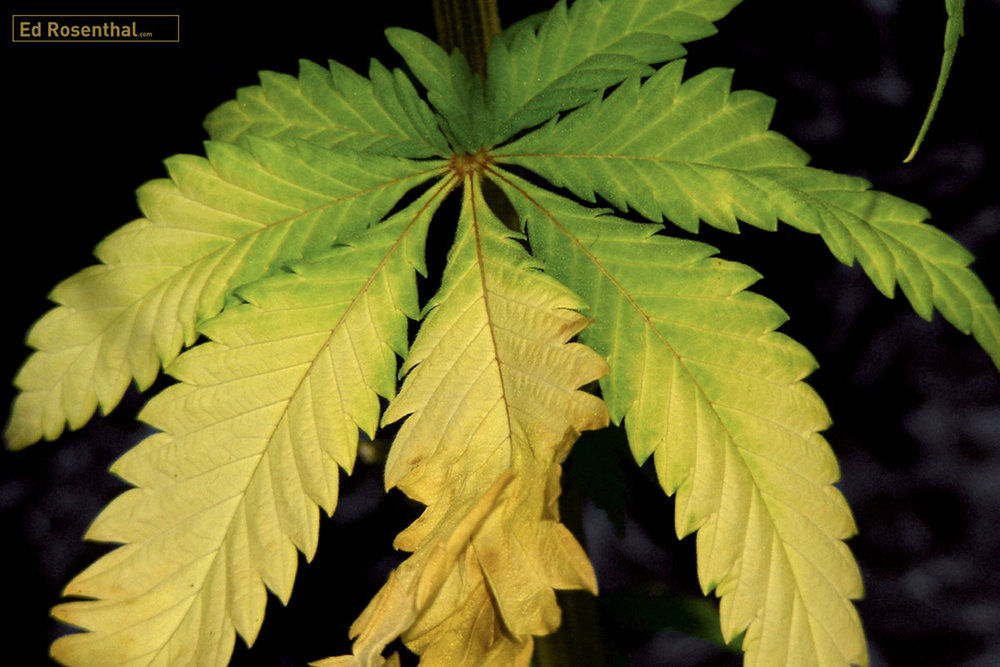In this series of articles, Growers Network talks about a few of the most common Cannabis conditions you need to watch out for. Today’s topic: Nitrogen Deficiency.

The following is an article produced by a contributing author. Growers Network does not endorse nor evaluate the claims of our contributors, nor do they influence our editorial process. We thank our contributors for their time and effort so we can continue our exclusive Growers Spotlight service.
Plant conditions can be a major headache in any grow operation and Cannabis has no shortage of them. So for today’s condition profile we’re going to discuss nitrogen deficiency, a condition you may find yourself dealing with in your grow if your nutrients aren’t adjusted properly.
Quick Look
- Common Name: Nitrogen Deficiency
- Scientific Name: Nitrogen Deficiency
- Symptoms: Chlorosis, leaf yellowing, stunted growth, dormant flowers
- Caused by: Excessive carbon, pH imbalance, insufficient nitrogen
- Timing: Any time
Nitrogen Deficiency
What is it?
Nitrogen deficiency is exactly as it describes -- a lack of enough nitrogen in the soil or medium to provide enough nutrients for the plant to properly grow.

What to look for
Nitrogen deficiency should be relatively simple to spot, but it can be confused for other nutrient deficiencies, or caused by problems other than sufficient nitrogen. Because nitrogen is a “mobile” nutrient, meaning that it can move out of older leaves into younger leaves, older leaves will display signs of a deficiency first.

Symptoms can include:
- ”Faded” or light green leaves.
- Older leaves yellowing, browning, or dying.
- Stunted growth
- Bud underdevelopment
How to Treat/Prevent
Identification
First, you need to make sure that you actually have a nitrogen deficiency before you start supplementing with additional nutrients. If you add too many nutrients, you could be aggravating a different problem with your plants!
To identify you have the “right” deficiency, check the pH and EC of your nutrient water in the line, and test the pH and EC of the runoff. If you see a drop in EC and pH remains constant, then your pH values are correct and you can check for other issues. If your EC doesn’t drop (or drops too much), or your pH varies, then you may have another issue. Check this article out for more details about runoff issues.
However, runoff tests aren’t always the most reliable. They are cheap and fast, but not a guarantee by any stretch. They also don’t tell you precisely what you’re missing. If you truly want to know what’s going on, you need to send in a tissue sample or soil sample to a lab and get their analysis.
Treatment
Treatment will depend on the aforementioned identification. If you find that your pH is outside of acceptable ranges (5.5-6.5), first correct your pH. If your EC is reading odd or abnormal values, then make sure there isn’t a salt buildup or precipitate in your feeding regimen.
If test results show a deficiency in calcium or magnesium, add a CalMag to your feeding regimen and see if the problem resolves.
And if you get test results back for low nitrogen, the solution is simple! Add more nitrogen!
Prevention
Prevention will be multifold. First, you need to monitor your soil/medium and feed water to make sure that you don’t have precipitate and your pH is in an appropriate range (5.5 to 6.5, slightly acidic). From there, if you are using an RO water system, make sure to add an appropriate CalMag supplement to your normal feeding regimen.
Finally, take regular soil or tissue samples into a lab for analysis. You should be able to spot potential issues in advance with your test results.
A Few Other Things
Nitrogen deficiencies may not actually be caused by a lack of nitrogen in your soil or medium! Several micronutrients play a role in how well your plants can absorb nitrogen. Other nutrients that can impact nitrogen availability for your plants include:
- Calcium deficiency
- Magnesium deficiency
- Excessive carbon (uncommon, but possible)
Additionally, a nitrogen deficiency during late flowering might not be cause for alarm, according to several sources, because the plant is pushing its last resources into flowers. If nitrogen deficiencies are showing at any other stage though, you may be having some problems.
So now you know a bit about nitrogen deficiency and what you can do to prevent it from ruining your grow. Have additional questions about nitrogen deficiency? You should join our forum where you can post pics and ask our expert community about this topic or any other!
Happy Growing!
10 Best Gift Ideas for Cannabis Connoisseurs and Growing Aficionados (2022)
December 7, 2022Developing and Optimizing a Cannabis Cultivation System
December 14, 2021Dealing with Insomnia: How Can CBD Help?
December 10, 2020Your Guide to Sleep and CBD
December 7, 2020
Do you want to receive the next Grower's Spotlight as soon as it's available? Sign up below!
Resources:
- Want to learn more about subjects similar to those touched upon in this article? Check out our articles on subjects such as:

Do you have any questions or comments?

About the Author
Hunter Wilson is a community builder with Growers Network. He graduated from the University of Arizona in 2011 with a Masters in Teaching and in 2007 with a Bachelors in Biology.